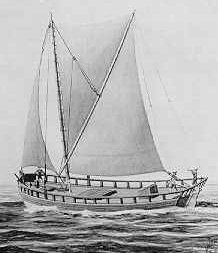
Posted on 03/28/2022 8:51:12 AM PDT by BenLurkin
An extensive new analysis published in the Journal of Archaeological Science: Reports has produced new and impressive evidence supporting the idea that the shipwreck found in 1863 was the Sparrow-Hawk, something shipwreck historians have long believed but were never able to prove.
Through the application of techniques that can accurately date wood and trace it to its place of origin, the scientists involved in this study have linked the pieces of timber found on a Cape Cod beach in 1863 to the shipbuilding industry of late 16th and early 17th century England. The 40-foot small pinnace ship that was scuttled just off-shore in Cape Cod in 1626 was built in England, and there are no other known shipwrecks in the region that match the characteristics of this vessel.
After leaving England in 1626, the small pinnace ship that came to be known as the Sparrow-Hawk crossed the Atlantic largely without incident. But near the end of their voyage, rough seas became more common, and before they could reach the colony of Virginia (their planned destination) they were thrown hopelessly off-course and battered into submission by a sudden and terrible storm. With control of the ship lost, its wrecking was inevitable, and it eventually sank in the shallow waters off the eastern shore of Cape Cod Peninsula near the settlement of Orleans, Massachusetts.
Following the wreck, two survivors were rescued by the indigenous Nauset people, who took them to the Plymouth Colony . Governor William Bradford dispatched men in a boat to rescue the remaining passengers and crew (there were 25 people on the Sparrow-Hawk in total), and it was Bradford’s written account of this incident that helped keep the memory of the shipwreck alive.
(Excerpt) Read more at ancient-origins.net ...

“Generally speaking, pinnaces were lightly built, single-decked, square-sterned vessels suitable for exploring, trading, and light naval duties. On equal lengths, pinnaces tended to be narrower than other types. Although primarily sailing vessels, many pinnaces carried sweeps for moving in calms or around harbors.”[3]
“The rigs of pinnaces included the single-masted fore-and-aft rig with staysail and sprit mainsail to the mizzenmast, and a square sprit-sail under the bowsprit.”
https://en.wikipedia.org/wiki/Full-rigged_pinnace
Where is the ship now?
40 feet?
My neighbor’s boat is bigger than that!.
Of course people were smaller back then..............
PinGGG!....................
Davy Jones’ Locker..............
Tougher too to sail a boat like that across the ocean! (Reminds of a Viking ship).

I’m not a boat person, used to have a 17 foot center console, but crossing the ocean in a boat that small is close to suicidal!................
It’s a secret. You have to read the article:)
Sparrowhawk! Makes me think of that enjoyable sequence of books!

I had a 22 cabin cruiser sailboat. I’ve read that you really want 36’ or more just to go to the Bahamas.
I read the article. Missed the last paragraph.
At least.
The Atlantic Ocean can be very sudden and devastating. Here on the Gulf Coast it’s a bit calmer seas...............
Got that Gulf Stream that’s pretty strong certain times of year. Even with a bigger boat, I’m not sure I could have gone out of sight of land. I sailed lakes.
"As a ship's boat, the pinnace is a light boat, propelled by oars or sails, carried aboard merchant and war vessels in the Age of Sail to serve as a tender. The pinnace was usually rowed but could be rigged with a sail for use in favorable winds. A pinnace would ferry passengers and mail, communicate between vessels, scout to sound anchorages, convey water and provisions, or carry armed sailors for boarding expeditions. The Spanish favored them as lightweight smuggling vessels while the Dutch used them as raiders."Pinnace (ship's boat)
Imagine taking a small tender across the ocean with 25 people on board! It isn't exactly an ocean-going vessel.

I have a house along the Outer Banks in NC. Built in 1903 and as with a number of old houses built in that period, some of the original framing under the house are beams salvaged from an old shipwreck.
We were heading back from the Bahamas a few Summers ago and that day there happened to be a charity event going on. Folks were going from Bimini to FL on stand-up paddle boards. Each one had an escort boat with it, probably 40-50 entries.
Disclaimer: Opinions posted on Free Republic are those of the individual posters and do not necessarily represent the opinion of Free Republic or its management. All materials posted herein are protected by copyright law and the exemption for fair use of copyrighted works.